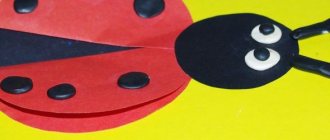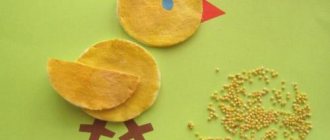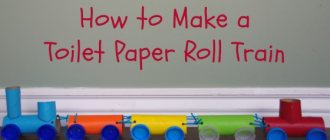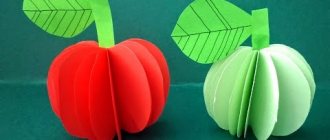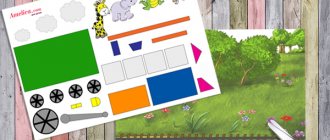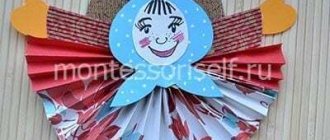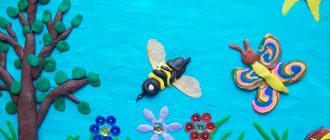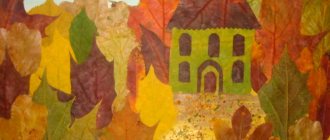For the successful all-round development of a child, activities to develop fine motor skills are of great importance. One of the types of such activities is applications made from colored paper, templates for which were developed by methodologists taking into account the characteristics of the age groups of preschoolers.
It is important that the complexity of the task corresponds to the age of the child, that classes are carried out systematically, gradually becoming more difficult, and are carried out under the supervision and assistance of adults.
What are the benefits of template applications for development?
Paper applications are a creative process through which children learn about the world around them and acquire many skills. In addition to the development of fine motor skills of the hands, this includes coordination of movements, the study of colors and their combinations, the concept of composition, familiarity with various materials and textures, the development of observation, imagination and fantasy.
Working on an application in a team promotes organization, restraint, and accuracy. It is also necessary to note the development of spatial imagination: when doing appliqué, children create a whole from several components and, conversely, learn to divide the whole into parts.
Scientists have proven that in the cerebral cortex, the center responsible for fine motor skills is located next to the speech center and contributes to the development of speech skills.
Compliance with safety regulations
Children's creativity is a fascinating process. But it is important to remember that in the hands of a child, scissors, glue, needle and thread, buttons and small craft items can be potentially dangerous.
Parents must show how to use all this correctly so that trouble does not happen.
Making applications is an important part of the pedagogical and educational process. By working with simple images, fine motor skills of the hands develop, spherical imagination and abstract thinking are formed.
However, when working with preschool children, it is important to ensure that the child uses scissors correctly, does not put buttons in his mouth, or tastes the glue.
Safety rules for preschoolers are taught in kindergarten. Children whose mothers and grandmothers sit at home often do not know basic things. Therefore, in the absence of adults, potentially dangerous items should be kept out of reach.
Children, wanting to repeat the creative process, may take something without permission and use familiar objects in some other way.
Simple applications for children 2-3 years old
Simple applications made from colored paper using templates can be practiced from the age of 2. However, some experts believe that children as young as 1 year can perform feasible tasks.
Initial lessons involve gluing pieces of paper onto a sheet in any form. At this stage, the child must understand and remember the basic actions: spread, turn over, apply, smooth. Kids are still attracted to the process itself; they will strive for the result later.
At the second level of complexity, templates are used. The child must place the elements also chaotically, but within the contour, and a certain image appears.
Application template from colored paper “Hedgehog”
A template is a schematic image of a future picture, drawn or printed on a printer. Simple templates for applications made from colored paper can include, for example, a Christmas tree with balls, a tree with apples, and others.
For such work, you need to prepare elements: balls, apples, etc. The child must determine for himself how to arrange them on the templates.
Palm tree applique template
Flower applique template
For small children, it will be interesting to perform a simple cut-out appliqué. The child watches the adult tear the paper into long strips, then tears them into shreds himself. These pieces need to fill the outline.
If the child wants to tear the paper himself, then these uneven, awkward strips can also be used to create an applique, for example, grass. Ants are drawn using finger paints.
Further, the task becomes more complicated: you need to hit the element on a specific place in the template or drawn outline. So, using cut out circles, an image of a caterpillar is created. At this stage, children are no longer interested only in the process, but also in the result.
When making appliqués from colored paper using templates and contours with children under 3 years of age, prepared cut out elements are used.
A three-year-old child can already be taught the skills of working with scissors with rounded ends.
At the same time, it is necessary to explain how to properly hold scissors and paper so as not to get hurt. You need to start with straight cuts, then work on bends and roundings.
At this age, children are already able to create simple plot pictures. Elements pasted onto the template allow you to create a specific image.
The background for the application can be a drawn outline with partially drawn elements. For example, children can populate a template aquarium with algae and stones at the bottom with inhabitants: fish, jellyfish, etc.
An interesting activity can be connecting and gluing a cut picture. If a child copes with such a task easily, it is recommended to complicate it: add raindrops to the umbrella, glue windows to the house with an attached roof. Such activities develop imagination, observation, and a sense of proportion.
Tips from the experts
A silhouette appliqué using dark shades of thick paper is considered a real work of art. In ancient centuries, such works were sold for large sums and were extremely popular among the nobility.
Connoisseurs of beauty note the high subtlety and taste of the master in such masterpieces, which is why many lovers of needlework strive to hone their skills in this direction. Making such crafts a reality is quite simple; a thick sheet of dark-colored paper is cut out according to a pre-drawn image with scissors.
The remaining material forms a silhouette so that the shape is not distorted; the frame is attached to the base. Such products are perfect for all kinds of exhibitions and competitions; prizes will be guaranteed.
Important! To decorate finished crafts, various small things are used; if you show your imagination, the applique will acquire a zest and stand out significantly from other items.
The more creative the master is in his approach to creating a masterpiece, the more interesting the appearance will become. The process itself cannot be called burdensome, and to prepare supplies and material you need to spend a little money from the family budget.
At the moment of implementing your plans, you can use ready-made ideas, but the most beautiful crafts are obtained by independently planning an algorithm of actions.
Applications for children 4-5 years old
At this age, colored paper applications and templates for them become more complex. By preparing, together with an adult, elements for a future picture, the child shows more independence: cuts, selects colors and, thus, gains an understanding of composition.
This activity develops logical thinking and allows you to show creative inclinations.
For children 4-5 years old, a fun activity is making cards, which they then give to their parents and friends.
The base is folded in half and elements are glued inside the postcard to form a plot picture.
The templates developed by specialists are only examples indicating the direction of work.
Parents and educators can contribute their ideas. For example, using a cut out outline of a baby’s palm in an applique – such pictures evoke amazement and delight in children.
Applications with palm
The technique of appliqué using only circles reveals for the child the relationship between the parts and the whole.
When developing a child’s creative imagination, you should show him various techniques for working with paper: for example, folding it in the shape of an accordion. For such a picture you need to prepare a base and draw contours. The gluing process also becomes more complicated.
Designer use of applique crafts
This activity will appeal not only to children, but also to adults. The versatility of paper and working with it allows it to be used in most design cases.
To begin with, you can simply look into a store that offers a large assortment of paper products related to handicrafts. The process of choosing from numerous options is so exciting here that you can spend a lot of time and not regret it at all.
If you have an idea in your head about how to transform the appearance of your apartment, then making paper decor is an inexpensive and versatile tool. Floral displays, the presence of volumetric elements, elegant pendants from garlands are not a complete list of all kinds of decorations.
Of most DIY crafts, appliqués are the best option in terms of savings and variety.
Complex applications for children 6-7 years old
Children of senior preschool and primary school age already have certain skills.
Practicing appliqué work from colored paper using templates during this period helps further develop fine motor skills, thinking, memory and concentration, and develops the ability to plan one’s activities.
An important circumstance is that the child foresees the final result of his work.
At this age, children develop the skill of cutting out individual parts and solid silhouettes, symmetrical elements from paper folded in half, as well as the ability to create compositions and correctly arrange their individual parts on a base.
At this stage, children study color combinations, analyze and compare details. The texture of the material also becomes varied: in addition to ordinary colored paper, creped (“crumpled”), streaked (glossy), textured (embossed or imitating velvet), and foil are used.
During this period, you can move on to volumetric symmetrical compositions.
To complete this task, templates (clouds, balloons) are cut out in the usual way. Next, two identical templates are folded in the center and fastened together (can be sewn). The prepared elements are glued to the base.
To make a three-dimensional bird, the template is folded in half and glued together, except for the wings, which are folded along the dotted line.
The resulting result can be pasted with one side and a wing onto the base (in the form of an applique) or turned into a craft by tying it to a thread and hanging it on a branch.
Having mastered the basics of composition at the previous stages, children aged 6-7 years are able to create entire paintings - landscapes, still lifes, using ready-made templates for appliqués from colored paper or making them with the help of a teacher or parents.
Plastic look
The latest existing technique also does not involve the use of scissors; the components of the future masterpiece are created using hands.
- The prepared sheet of paper needs to be wrinkled well, after such manipulations it will become more plastic and pliable for work.
- The crumpled texture is used to form the desired shapes, which should be pre-thought out and distributed on the base.
- To glue products, you should apply liquid in the places where the pieces come into contact with thick cardboard or whatman paper; these areas can be determined by applying the form.
Applications using a disposable plate
Disposable plates are a convenient material with which you can create original and beautiful compositions. Made of polystyrene or cardboard, of different colors, with different embossed patterns, they can be both the basis for an applique and elements for it.
You can involve children from a young age in making applications from colored paper on a disposable plate using templates. On a prepared colored background, children arrange simple elements in the form of a pattern.
A more complicated option is to use two or more colors for the background and more complex elements. Children 6-7 years old create thematic compositions on plates or use them as material for individual elements.
Examples of gradually more complex appliqués on plates:
Creativity on fabric
Applique on fabric is an interesting way to decorate clothes. This way you can decorate both adult and children's things. Many couturiers, from classics to modern ones, deservedly pay great attention to this type of decoration.
To decorate clothes or bags like a fox, you need several pieces of fabric - 10 by 10 cm orange, 5 by 5 cm white. You also need black thread and an embroidery needle.
First, a blank is drawn on paper - the fox's head, body and tail. Then draw two triangles - for the muzzle and for the chest. The resulting designs are transferred to fabric and cut out.
The blanks are sewn to the base from the front side. You can do this with a sewing machine or sew on by hand.
To create a plot, flowers and butterflies are sewn near the chanterelle. You can cut them out of fabric and use curly buttons.
The edges of the fabrics can be processed or left free - any option has a right to exist. A fox does not have to be red - even a purple animal will look interesting.
Applique on fabric is a universal way to decorate things, simple and affordable. Since the work requires scraps of material, this gives a lot of scope for imagination.
Combined applications
When making appliqués from colored paper, the patterns can be diversified by combining different materials.
Cereal applications
This type of application can be done even with small children. The algorithm of work is as follows: an adult applies glue to the prepared drawing, the child sprinkles cereal on it and lightly presses it with his finger.
The remaining grains that are not glued need to be shaken off. This activity instills attentiveness and accuracy in the child.
Older children can use different types of cereals. In this case, the glue is applied one by one to individual areas. To make the picture more colorful, it is recommended to first tint the cereal with gouache in different colors. You can use your child’s own drawing as a template; this will stimulate him and inspire him.
Button applications
To perform such an application, preliminary preparation is necessary. After studying the drawing and choosing colors, the child, with the help of adults, selects buttons that match the color and size. Then you should lay them out in a picture to visualize the desired result, and begin gluing.
For younger children who do not yet have the necessary skills, you can apply a drawing according to a template on a layer of plasticine - the child will attach the buttons by pressing. This technique is also applicable when working with cereals.
For combined applications, cotton wool, napkins, eggshells, natural materials - leaves, petals, seeds and much more are also used.
Preparing to perform applications
Before such classes, it is important to do preparatory work. You can, for example, look at drawings, paintings, read fairy tales, get acquainted with interesting phenomena, etc. Application classes can even be conducted according to a certain algorithm:
- Creating an atmosphere of interest and a favorable emotional mood through games, reading poetry, and interesting skits.
- It is better to start working with an acquaintance with the depicted object (feeling and looking), the teacher’s recommendations and the suggestions of the children themselves.
- Then the children can be asked to cut out the elements, coat them with glue and fix them on paper. During this process, the teacher must help children in case of difficulties during the work. At the end, be sure to invite them to trace their work with a felt-tip pen.
- Upon completion, the finished work is examined and necessarily positively evaluated, since praise for effort is very important to the child, and besides, he learns to evaluate his own and other people’s work.
Multilayer applications
Multilayer (overlay) applications made of colored paper or other materials are made using templates designed or made independently.
This kind of work develops spatial imagination and cultivates aesthetic taste. They are made from paper, fabric, leather, felt - the main thing is that the edges of the material do not fray.
Multilayer applications, like other varieties, come in varying degrees of complexity. For little ones, this is a simple matter of gluing parts on top of each other. By fastening elements only on one edge, you can create a three-dimensional effect.
More complex appliqués have more details and require good scissor skills and a sense of proportion and color.
Older children, with developed fine motor skills and the skills to make complex parts, create real works of art - unusual compositions and even portraits. Light and shadow effects give them special color.
Multilayer appliqué is a truly creative process in which the child’s imagination and artistic abilities are revealed. It is necessary to think through the image, color scheme, and sequence of action, so this type of work requires a certain level of intelligence.
Making a hedgehog with your own hands
The second option, which you can even make with your child for an exhibition in kindergarten, is a funny paper hedgehog. The inventory list remains the same.
Regarding the instructions:
- Making needles - one of the best options is to put your child's hand on dark paper, trace and cut out the shape yourself.
- You need to make about 4-5 such products per craft.
- Next, the palms are arranged and glued together to form small needles on the hedgehog’s back.
- The hedgehog itself can be downloaded on the Internet, printed on paper and cut out in advance.
Next, all the parts are connected, eyes and additional objects are added, for example, fruits. The child can perform them in the “ragged style”.
It is enough to draw an apple and a pear on colored paper so that the child can trace the outline of the picture.
Piece applications
Appliqués made from cut or torn pieces of colored paper using templates are quite simple and can be done even by small children. You need to apply a drawing to the base sheet. In addition to ready-made templates, you can use children's coloring books or come up with a sketch yourself.
The production of appliqué elements is carried out together with the child - small children happily tear the paper into pieces. If you already have skills in working with scissors, you can allow these elements to be cut out.
An important detail: the younger the child, the larger the fragments should be.
Having selected the desired colors, you can begin gluing.
The glue is applied not to small parts, but to the template, in sections. When working with children, this process is carried out by an adult; older children themselves apply the glue with a brush. When gluing pieces of paper, the child must accurately fall into the outline.
A type of applique made from pieces is trimming. This technique is quite complex, but children 6-7 years old are quite capable of it, especially when working in a group.
To master the cutting technique, teachers and parents are offered master classes on this topic.
Volume of applique crafts
Creating a pattern by gluing multi-colored pieces of fabric or paper - applique. Making a three-dimensional applique craft is not an easy task. However, having the initial simple skills to create such images, you can engage in such creativity.
If you devote a little time to activities with your baby every day, then little by little, without much difficulty, he will master this technique and independently “create” to the delight of himself and those around him. For such crafts, you need to stock up on colorful paper, glue, scissors, cardboard and a stencil. Good luck.
Autumn themed applications
The bright colors of autumn make it possible to create colorful pictures of autumn nature. For applications on this theme, both colored paper and natural materials are used: multi-colored leaves, petals of late flowers, seeds, spikelets, twigs and other objects.
When making autumn-themed applications from colored paper using templates and in a free composition, the main attributes are preserved - flowers, mushrooms, fruits, acorns, and tree silhouettes are cut out and painted. An obligatory component is autumn leaves.
When working with natural material, you need to prepare it. The collected leaves must first be leveled and dried under pressure. If the leaf needs to be given any shape, then a fresh leaf is used for this, which is then dried.
For collages and mosaic paintings, you can prepare cardboard templates onto which the elements are glued.
Autumn nature is fertile ground for the flight of children's imagination. Leaf applications placed in a photo frame will decorate any interior.
Autumn lanterns will also be a spectacular decoration. To do this, the outside of the glass vessel is covered with multi-colored leaves (paper or natural), and a small candle is placed inside.
Plot
Thanks to the universal materials used in the work, absolutely any theme can be used in applique crafts for children. It says here what human imagination is enough for.
Most often, the basis of the work is based on such subjects as:
- the story of a cartoon character;
- description of animals;
- favorite toy;
- the beauty of the natural world;
- New Year's or other holidays.
These stories are only a tiny part of what can be composed. Having an inquisitive mind, a person can create a story that everyone will be delighted with.
Winter themed applications
To create winter and, in particular, New Year's applications, any of the described techniques is used, depending on the age of the children.
The most common type of winter applique is snowflakes - this is a subtype of silhouette type applique. It is recommended to fold the sheet correctly, trim the edge and sharp corner, and make cuts on plain paper first - this is how the skill is developed.
In addition, pendants made of such snowflakes decorate the room. Thin, airy snowflakes can be glued to windows and other surfaces.
For small children, it is better to prepare templates (circles with an outline) and make a broken snowflake from pieces. For flat, voluminous, multi-layer snowflakes, you need to prepare patterns for cutting.
To make a traditional Christmas tree, kids use triangles from green paper, a snowman is made from white circles, and a teacher or parent helps add details to the applique.
Older children can be asked to make a Christmas tree from strips of paper or create a picture of a winter forest using templates using small pieces of paper or cotton wool.
A Christmas tree made of paper balls looks bright and voluminous. For this purpose, a template and elements are made from crepe paper. The main color is dark green; multi-colored balls are made for the garland.
After applying glue to the template, it is recommended to first position the garland, then fill the outline with “needles” and complete the applique with a star and base.
An interesting applique depicting winter accessories allows children to show their creative imagination.
The hat and mittens can be decorated with any ornament, animal figures, winter pictures, beads or rhinestones.
Cotton wool is used to imitate fur.
Using a disposable plate, you can make a polar bear mask craft. Holes are cut out in the plate for eyes, the surface is covered with pieces of paper, and a disposable cup is used for the nose.
Senior preschoolers and elementary school students are able, under the guidance of adults, to create complex winter landscapes using mixed techniques.
A little about the types of applications
By topic, the following types of applications can be distinguished:
- Subject - a simple type of application for children. An element is cut out of the material and glued to the base.
- Subject - the image no longer consists of one, but several links that make up an event or action in the background.
- Decorative - forms a repeating pattern that is used to decorate albums, frames and household items.
Paper is the main material for applique. However, in addition to it, you can use other materials, whatever your imagination allows: fabric, leather, multi-colored beads, seed beads, woolen threads, leaves, seeds, cereals and much more.
By color, the applique can be colored, black and white or single color.
Depending on the volume, flat and volumetric applications are distinguished.
Overhead, cut-off, silhouette, modular, ribbon... and this is not all types of applique!
And to understand how diverse this art technique is, it is enough to get acquainted with the most popular and interesting types of children's applications, examples of which are given below.
Spring themed applications
Snowdrops and lilies of the valley, starlings and flowering trees - these signs of spring are traditionally used in children's applications made from colored paper using templates. The little ones perform simple tasks, placing prepared elements on the contours. These same images can be complicated by adding pictures of spring nature.
More complex compositions - voluminous, multi-layered, with a large number of elements - are created by children who have the skills to work with glue, scissors, a brush and use different techniques.
Lilacs in a vase made of cereals, a spring picture using drawing and appliqué techniques - these and many other ideas are offered by experts to parents and educators for educational activities with children.
Applique is a visual activity. Having achieved the desired result, the child experiences aesthetic pleasure, thereby joining the world of beauty, the world of art. A simple and accessible way for children to create artwork makes appliqué one of the favorite types of educational activities for children.
Geometric type crafts
The process is very exciting and has a positive effect on the development of young family members; geometric shapes occupy a central place in technology. Among the developing skills it is worth noting:
- Mathematical abilities.
- Fantasy.
- Aesthetic taste.
This solution can be easily compared to a board game; during work, all the details are initially laid out on the surface, the picture is adjusted, and the components are attached with PVA glue.
Making a flower meadow in the meadow
This option is ideal for those who are 5-6 years old. The work can not only be submitted to a spring talent competition, but also turned into a real greeting card.
What you need for creativity:
- Plastic safety scissors.
- Glue - you can use a pencil or PVA.
- A simple pencil or black pen.
- Set of colored paper.
- Thick cardboard for the base.
Now you can proceed with the instructions:
- If previously a stencil was used for work, this time parents do not have to make the process easier.
- The child can draw the flowers himself and then carefully cut them out along the contour.
- You also need to take care of the base - to make the background look more successful, you can paint a green field on it in advance with watercolors.
- After this, the flowers are carefully collected on the base and glued with PVA glue.
To ensure that the work dries evenly, do not place it near the battery. If creativity is urgently needed, you can dry the work with a simple hairdryer on medium setting.
To make a card, just fold the base into two equal parts before applying the flowers.
